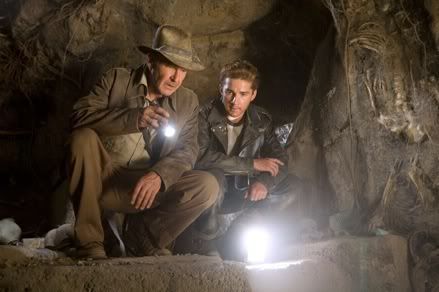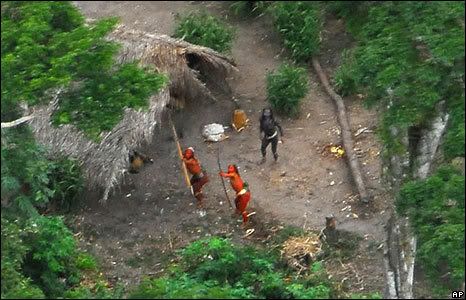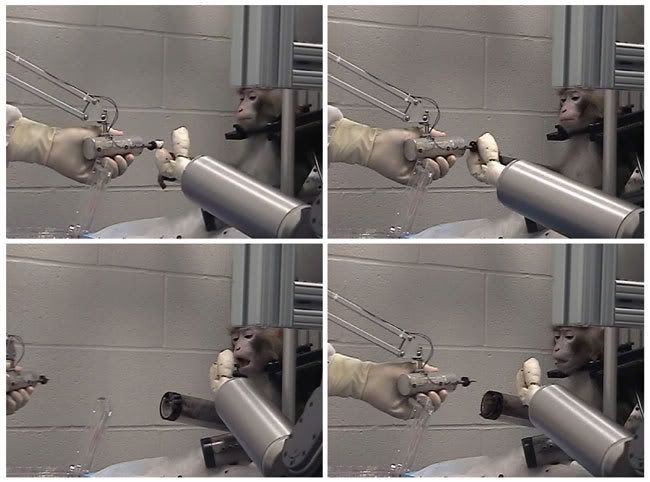 Let’s just say it: Indiana Jones and the Kingdom of the Crystal Skull is not an “Indiana Jones” movie. It has little to do with it’s predecessors, save for some flagrantly transparent references to the earlier trilogy. If anything, it’s a rip-off of a rip-off, having more in common with schlock like National Treasure and The Mummy than a classic like Raiders of the Lost Ark. To call it “tongue-in-cheek” would be putting it mildly—it is a total assault on seriousness.
Let’s just say it: Indiana Jones and the Kingdom of the Crystal Skull is not an “Indiana Jones” movie. It has little to do with it’s predecessors, save for some flagrantly transparent references to the earlier trilogy. If anything, it’s a rip-off of a rip-off, having more in common with schlock like National Treasure and The Mummy than a classic like Raiders of the Lost Ark. To call it “tongue-in-cheek” would be putting it mildly—it is a total assault on seriousness.
But now that that’s out of the way (and I think we’re in agreement so far), I really have to admit a couple points to myself: 1), National Treasure and The Mummy—and, indeed, Crystal Skull—have such an unabashed joyfulness in reckless adventure that I find myself admiring their offhandedness, and 2), The visual wit of Raiders (and, to a lesser extent, Temple of Doom and Last Crusade) is still here—it’s just buried under layer after layer of self-referential citation.
Too often, movie sequels inspire an obligatory “checklist” in their audience (and, for that matter, their filmmakers)—and I think the more beloved the original, the truer this axiom. Fedora? Bullwhip? Underground tomb? It’s all here, and then some. You’ll find, among other thematic repeat offenders, secrets hidden in plain view (sometimes right under your feet!), issues of trust and duplicity (i.e., “So what are you, some kind of... triple agent?”), and righteousness in the face of greed (“Their treasure wasn't gold, it was knowledge.”). But this is a dangerous game for filmmakers, as no two viewer’s expectations are ever the same. Favor conservatism, and the film is labeled a retread. Sway too far into novelty and fans complain about the changes. It’s the proverbial double-edged sword (though you could argue that the best solution would have been to simply not make another Indiana Jones movie…but that’s a moot point. Where there’s money to be made…).
So, of course, Steven Spielberg, George Lucas, and screenwriter David Koepp made incredible miscalculations in the plot. Gone is the user-friendly Christian mythology that was so successful for Raiders of the Lost Ark and Last Crusade. Instead, we’re treated to a convoluted story about Soviet communism, parapsychology, mind-control, Aztecs, aliens, and expected (but tiresome) questions of parentage. And, unfortunately, that’s it—it doesn’t add up to anything. Plot points are hit, pert jokes each have their turn, and one regurgitated sequence after another only serves to remind you of another time in the series when Spielberg and Lucas and Harrison Ford pulled it off better. And because each of these moments comes packaged with its own pre-made punchline, based solely on recognition, the purpose of the 'jokes' is to “get” the 'jokes' (i.e., that Indy is old, that ants are the new snakes, etc.). Sometimes this works—like when Indy shifts gears into problem-solving mode (watching Ford as Indiana Jones is a kick, as he reinhabits the ticks and mannerisms of his most iconic character)—but usually it doesn’t (see: “ants are the new snakes”).
But that assessment's not totally fair, and I say that for two reasons. One, because even when the gears aren’t quite lining up and you can feel the effort behind the hamhandedness, there’s still some genuine pleasure to be gained from the attempt. Cate Blanchett makes as unconvincing a Soviet spy as I’ve ever seen, but the slipping accent and cartoon-dominatrix persona seem to be what makes the role fun (for her and, maybe, us). And when Blanchett asks Indy to find a single artifact in an eerily familiar military warehouse, stocked with wooden government crates—well, of course Indy hasn’t been there before and won’t know his way around, but…hasn’t he? It’s like the characters know as much about themselves as we (the audience) do, and because we’ve already seen such an enormous storage center (in Raiders), what’s the point in pretending we haven’t? Simply, places like that don’t exist in reality, but we believed it 17 years ago, so the characters themselves are willing to unquestionably believe in such a space.
And two, while the story is lacking, it’s the deft visual eye of Steven Spielberg that elevates Crystal Skull, if not to Ark/Temple/Crusade levels, than at least to the positive side of The Phantom Menace. Notice how even the most rote sequence can have moments of brilliance. For example, Crystal Skull begins on a highway in the Nevada desert, with a chain of military vehicles being passed by a speeding car full of teens in poodle skirts. Yes, it’s a lazy device to establish that we’re in the 1950’s, but pay attention to Spielberg’s camera movement. Before the lead truck is overtaken by the car, as they’re side-by-side, the frame moves from the point-of-view of the sock hoppers, to between the vehicles (reflecting the moving car in the truck’s side mirror), and then through the window into the truck, mischievously shifting the POV from flippant to combative in one fluid movement—and perfectly setting up the deadly confrontation at the military base. This kind of elegant and playful (and presumably difficult) camerawork makes for subconsciously compelling viewing.
So where does that leave me? Indiana Jones and the Crystal Skull is, at times, a discombobulated mess. But certainly a tentpole picture like this is almost exclusively about spectacle, and as a serial adventure it doesn’t have to follow all the established rules of logic, or even come close to them, right? Therefore, maybe Crystal Skull has more in common with the “Indiana Jones” spirit than I (and it’s detractors) would like to believe—not because it rehashes all the past successes of the series, but because it harks back to the pulp serials of Steven Spielberg and George Lucas’ childhoods (which inspired the character in the first place). Where else would you find man-eating ants and an adventurer swinging through the vines of a rainforest? Isn’t it kind of refreshing to have a movie as enamored with logic and history as The Da Vinci Code, but function without the deadening weight of it’s own bloated self-importance (which, perhaps, explains the venture in plot from the spiritual to the supernatural)?
Inevitably, though, Crystal Skull doesn’t quite work. It’s like drawing in a coloring book. Though you may have all the “perfect” colors from your crayon box, sometimes you’re just stuck with the wrong picture for what you’ve got. Sure, the sun isn’t supposed to be purple, but damn if it’s not a pleasant shade of purple, and kind of endearing in it’s kindergarten simplicity.







